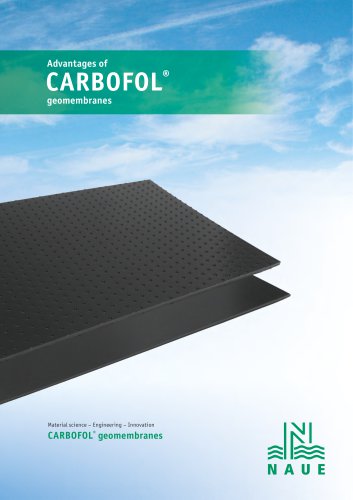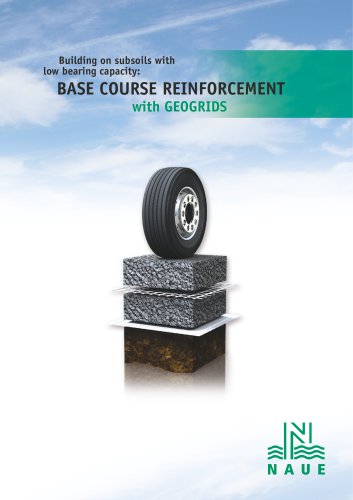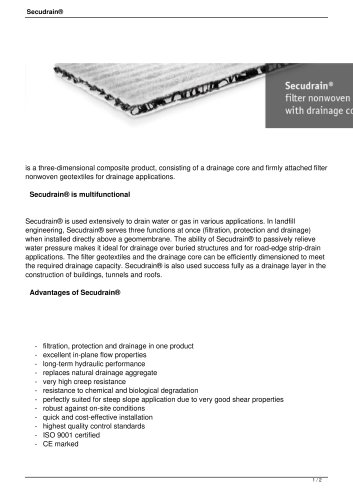
Catalog excerpts

SOIL REINFORCEMENT, SEPARATION AND FILTRATION
Open the catalog to page 1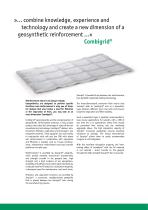
»… combine knowledge, experience and technology and create a new dimension of a geosynthetic reinforcement …« Combigrid® Secutex® is bonded firmly between the reinforcement bars by NAUE’s patented welding technology. Reinforcement alone is not always enough. Geosynthetics are designed to perform specific functions and reinforcement is only one of them. For designs that also involve a need for filtration or the separation of fines, you may look to an extra dimension: Combigrid®. Combigrid® geocomposites are the next generation of geosynthetic reinforcement products, a truly unique product...
Open the catalog to page 2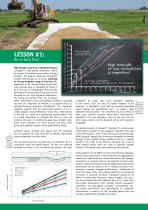
LESSON #1: Be an Early Riser High-Strength at Low Strain = High Tensile Modulus Combigrid®’s high-quality components define its success. As a reinforcement product first and foremost, the geogrid component (Secugrid®) exhibits high-strength at low strain, especially in the key elongation range of less than 2%. Depending on the manufacturing process geogrids typically have an elongation at failure of up to 15%, but in reality geogrid reinforced road pavements or reinforced earth structures are not designed for this high degree of deformation. The critical and realistic strain rate of...
Open the catalog to page 3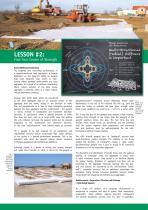
Find Your Center of Strength Radial Stiffness/Interlocking The longevity (and economical performance) of a geogrid-reinforced road application is heavily dependent on the geogrid’s ability to develop high shear resistance (also known as interlocking effect) between reinforcement and base aggregate. As a result of an optimum interlocking effect, lateral restraint of the base course aggregate is achieved, which as a result reduces vertical deformation (rutting). Stresses from traffic loads, which are transferred to the base aggregate lead to an outward motion of the aggregate from the wheel,...
Open the catalog to page 4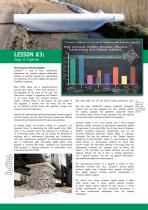
LESSON #3: Keep It Together The Importance of Torsional Rigidity Combigrid® is used in many reinforcement applications, but roadway subgrade stabilization provides an excellent example for understanding the importance of torsional rigidity (aka Aperture Stability) in a geogrid: When traffic passes over a geogrid-reinforced granular base course, a shear stress develops in the aggregate on the plane of the grid. This shear stress changes in magnitude and direction as the wheel passes. The changing direction causes a twisting motion in the geogrid. The main motion of the aggregate is outward...
Open the catalog to page 5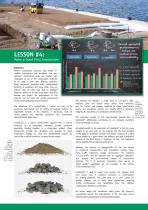
Make a Good First Impression Robustness Modern construction practices may enable incredible installations and structures, but geotechnical construction sites are loaded with challenges to all of the construction materials to be used in the work. Weather exposure, heavy equipment, imperfect soils, inexperienced handling of materials, and many other risks are present. Any of them may lead to damaged materials before or during installation, and that damage can impact the performance of the material and not least the overall performance of the constructed geotechnical structure. The robustness...
Open the catalog to page 6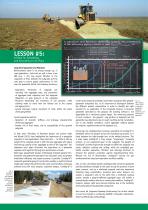
LESSON #5: A Place for Everything, and Everything in Its Place Long-Term Separation and Filtration Reinforcement alone is not always enough e.g. in road applications. Soils that are soft or have a low CBR (e.g. < 3%) may require filtration or the separation of fines between the subgrade and the road base to ensure proper performance. In this case the geotextile fulfills the following functions: - Separation: Prevention of subgrade soil intruding into aggregate base, and prevention of aggregate base migrating into the subgrade (Reduction of pore pressure in the subgrade) - Filtration:...
Open the catalog to page 7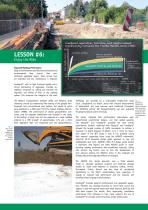
LESSON #6: Enjoy the Ride Improved Roadway Performance Geogrid reinforcement provides more economical and environmental base courses than nonreinforced aggregate layers. Road service lives are extended and less maintenance is required. Combigrid®, with its high torsional rigidity and a strong interlocking of aggregate, provides exceptional resistance to rutting and prevents the migration and mixing of fines in the roadway system. This preserves the integrity of the road. The Western Transportation Institute (WTI) and Montana State University carried out noteworthy field testing of the...
Open the catalog to page 8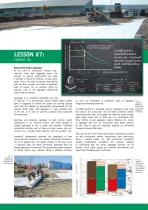
Reducing the Need for Aggregate As the costs of construction increase (e.g., materials, labor, fuel, aggregate taxes), the strength of geogrid reinforcement can make it possible to reduce the thickness of base course layers. And as the miles of roadway responsibility grow for cities, counties, and states, a significant scale of savings can be achieved simply by reducing some of the aggregate traditionally used in road construction. Aggregate is an expensive commodity, not only in cost but in its environmental impact. Roads require specific types of aggregate to achieve the proper soil...
Open the catalog to page 9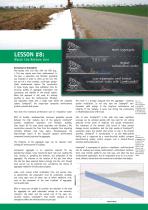
Watch the Bottom Line Saving Cost on Installation Poor-quality soils and sites with low CBR (e.g., < 3%) may require more than reinforcement. In the past, a separation and filtration geotextile was installed in order to shore up the soil. This was part of a more complex, multi-layer geosynthetic reinforcement system. The construction of these single layers took additional time for ensuring quality of aggregate installation and consistency and stability of the overall system. While this approach is still used, it’s entirely possible to serve the reinforcement, filtration, and separation...
Open the catalog to page 10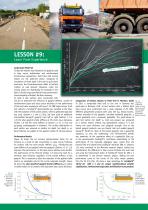
Learn from Experience Large-Scale-Field Trial To describe realistic load situations for geogrids used in base course stabilisation and reinforcement infrastructure applications, field trials with moving wheels are the preferred choice. Compared to simulations of wheel loads in the lab via cyclic plate load tests, the three-dimensional effect of particle rotation as well dynamic influences under the moving wheel can realistically be simulated in the field. In 2016 a large-scale field trial was performed in the municipality of Tostedt, Northern Germany. In total 8 test sections were...
Open the catalog to page 11All NAUE catalogs and technical brochures
-
Secugrid® HS
4 Pages
-
Combigrid®
4 Pages
-
Secugrid® PET/PP
4 Pages
-
CARBOFOL® geomembranes
4 Pages
-
geotextile introduction
4 Pages
-
SECUTEX® Soft Rock
4 Pages
-
MINING and GEOSYNTHETICS
11 Pages
-
BENTOFIX® X
4 Pages
-
BENTOFIX®
4 Pages
-
LANDFILL Engineering
13 Pages
-
Civil engineering
32 Pages
-
Tunnel construction
16 Pages
-
NAUE_Renewable_wind_energy
8 Pages
-
Secugrid® PDF
3 Pages
-
Secudrain® PDF
2 Pages
-
Combigrid® PDF
2 Pages
-
Bentofix® PDF
3 Pages
-
Carbofol® PDF
3 Pages






